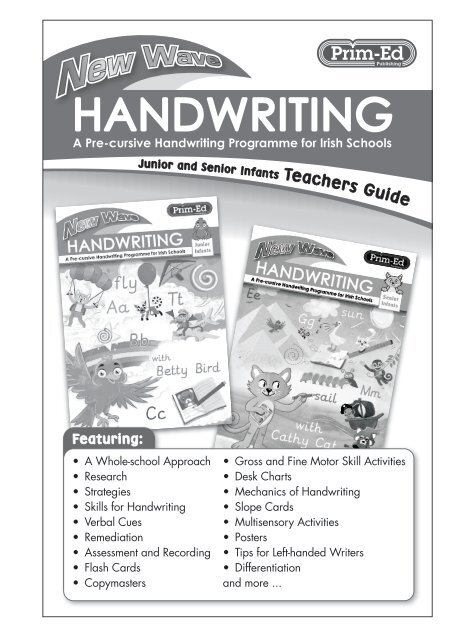PR-2888IRE New Wave Handwriting Teachers Guide - Junior and Senior Infants
You also want an ePaper? Increase the reach of your titles
YUMPU automatically turns print PDFs into web optimized ePapers that Google loves.
FOREWORD<br />
The <strong>New</strong> <strong>Wave</strong> <strong>H<strong>and</strong>writing</strong> <strong>Teachers</strong> <strong>Guide</strong> provides a comprehensive resource to support the full-colour h<strong>and</strong>writing pupil<br />
books for <strong>Junior</strong> <strong>and</strong> <strong>Senior</strong> <strong>Infants</strong>. The <strong>Teachers</strong> <strong>Guide</strong> provides general background information about h<strong>and</strong>writing <strong>and</strong><br />
a plethora of teaching resources to enhance the teaching <strong>and</strong> learning of h<strong>and</strong>writing.<br />
GENERAL INFORMATION ........................... 2–97<br />
About the Series .....................................2–4<br />
Introduction to <strong>H<strong>and</strong>writing</strong> ............................5–7 Dot-to-dot Pictures ...............................109–110<br />
A Whole-school Approach to <strong>H<strong>and</strong>writing</strong> .................8–10<br />
Lesson Plan for <strong>H<strong>and</strong>writing</strong> .............................11<br />
Weekly Teaching Plan Sample ...........................12<br />
Teaching Strategies for <strong>H<strong>and</strong>writing</strong> ....................13–15<br />
Mechanics of <strong>H<strong>and</strong>writing</strong> ...........................16–20<br />
<strong>H<strong>and</strong>writing</strong> Lines .....................................21<br />
The <strong>H<strong>and</strong>writing</strong> Font ...............................22–27<br />
<strong>H<strong>and</strong>writing</strong> Skills ..................................28–30<br />
Assessment <strong>and</strong> Recording ..........................31–34<br />
Class Checklists ...................................35–36<br />
Left-h<strong>and</strong>ed Writers ................................37–38<br />
Vision-impaired Writers ................................38<br />
Remediation .....................................39–42<br />
Differentiation <strong>and</strong> <strong>H<strong>and</strong>writing</strong> ..........................43<br />
Warm-up Exercises .................................44–45<br />
Finger Plays <strong>and</strong> Action Rhymes .......................46–51<br />
Multisensory Activities ..............................52–54<br />
Physical Development Activities .......................55–58<br />
Flash Cards ......................................59–71<br />
Alphabet Tracing Sheets .............................72–77<br />
Verbal Cues for Letter Formations ......................78–85<br />
Mini Posters ......................................86–94<br />
JUNIOR INFANTS SUPPORTING MATERIALS. ........... 95–141<br />
Individual Checklist ...................................95<br />
Assessment—Letter Size And Positioning ................96–97<br />
Assessment—Lowercase Letters .........................98<br />
Differentiated Assessment ..........................99–102<br />
Joined Digraph Practice ...........................103–106<br />
CONTENTS<br />
Colouring Picture ....................................107<br />
Tracing Picture ......................................108<br />
Mazes ........................................111–112<br />
Patterns <strong>and</strong> Pattern Pictures .......................113–137<br />
Character Poster .....................................138<br />
Desk Chart .........................................139<br />
Character Spacing <strong>Guide</strong>s .............................140<br />
SENIOR INFANTS SUPPORTING MATERIALS. .......... 144–193<br />
Individual Checklist ..................................145<br />
Class Checklist ......................................146<br />
Pupil Self-Assessment ................................147<br />
Assessment—Lower-case Letter Size <strong>and</strong> Positioning .....148–149<br />
Assessment—Lower-case Letters ........................150<br />
Assessment—Upper-case Letters ........................151<br />
Differentiated Assessment .........................152–155<br />
Assessment—Pangram ...............................156<br />
Joined Digraph Practice ...........................157–160<br />
Colouring Picture ....................................161<br />
Tracing Picture ......................................162<br />
Dot-to-dot Pictures ...............................163–164<br />
Maze .............................................165<br />
Patterns <strong>and</strong> Pattern Pictures .......................166–190<br />
Character Poster .....................................191<br />
Desk Chart .........................................192<br />
Character Spacing <strong>Guide</strong>s .............................193<br />
GLOSSARY 194–196<br />
Review sample<br />
Prim-Ed Publishing www.prim-ed.com 978-1-84654-938-0 NEW WAVE HANDWRITING TEACHERS GUIDE JUNIOR AND SENIOR INFANTS 1
ABOUT THE SERIES<br />
The <strong>New</strong> <strong>Wave</strong> <strong>H<strong>and</strong>writing</strong> series consists of five full-colour pupil books for pupils in <strong>Junior</strong> <strong>Infants</strong> to 3rd Class; two<br />
comprehensive teachers guides for <strong>Junior</strong> <strong>Infants</strong> <strong>and</strong> <strong>Senior</strong> <strong>Infants</strong>, <strong>and</strong> 1st, 2nd <strong>and</strong> 3rd Class; <strong>and</strong> three teacher<br />
resource books with photocopiable pages for 4th, 5th <strong>and</strong> 6th Class. For teachers of pre-school pupils, <strong>New</strong> <strong>Wave</strong> Prewriting<br />
Patterns is also available, to develop pre-writing skills, directionality <strong>and</strong> h<strong>and</strong>writing mechanics in young pupils<br />
through tracing <strong>and</strong> colouring activities.<br />
PUPIL BOOKS<br />
In <strong>Junior</strong> <strong>Infants</strong>, pupils develop their fine motor skills to<br />
grip <strong>and</strong> control their pencil correctly, while learning to write<br />
letters with correct formation, size <strong>and</strong> positioning. Pupils<br />
trace <strong>and</strong> copy patterns, lower-case letters <strong>and</strong> simple<br />
words for each letter of the alphabet <strong>and</strong> for digraphs.<br />
letter. They are introduced to diagonal <strong>and</strong> horizontal joins.<br />
Throughout the skill pages, pupils continue to trace <strong>and</strong><br />
copy patterns, lower- <strong>and</strong> upper-case letters, words <strong>and</strong> a<br />
sentence for each letter. Pupils then apply their h<strong>and</strong>writing<br />
skills to complete various cross-curricular activities.<br />
In <strong>Senior</strong> <strong>Infants</strong>, pupils continue to develop their fine motor<br />
skills to grip <strong>and</strong> control their pencil correctly, while learning<br />
to write letters with correct formation, size <strong>and</strong> positioning.<br />
Throughout the skill pages, pupils trace <strong>and</strong> copy patterns,<br />
lower- <strong>and</strong> upper-case letters, simple words for each letter<br />
of the alphabet or digraphs, <strong>and</strong> simple sentences.<br />
The sequence of introduction of letters in the <strong>Junior</strong> <strong>and</strong><br />
<strong>Senior</strong> <strong>Infants</strong> pupil books follow the introduction of the<br />
sequence of sounds for Jolly Phonics . This includes<br />
digraphs. Words practised for each letter or digraph are<br />
high-frequency words.<br />
In 1st Class, pupils are introduced to cursive h<strong>and</strong>writing. It<br />
is linked to the script learned in <strong>Junior</strong> <strong>and</strong> <strong>Senior</strong> <strong>Infants</strong>.<br />
Entry <strong>and</strong> exit strokes are also introduced as pupils ready<br />
themselves for joined h<strong>and</strong>writing. They revise body; head<br />
<strong>and</strong> body; body <strong>and</strong> tail; <strong>and</strong> head, body <strong>and</strong> tail letters.<br />
Pupils learn to identify <strong>and</strong> classify letters as anticlockwise,<br />
clockwise or downstroke letters, based on the initial or<br />
predominant directional movement used when forming the<br />
TEACHER RESOURCE BOOKS<br />
In 4th Class, pupils revise anticlockwise, clockwise <strong>and</strong><br />
downstroke letters; capital letters; <strong>and</strong> horizontal <strong>and</strong><br />
diagonal joins. Body; head <strong>and</strong> body; body <strong>and</strong> tail; <strong>and</strong><br />
head, body <strong>and</strong> tail letters are also revised. They become<br />
aware of the need for fluency <strong>and</strong> speed while writing in<br />
cursive. Throughout the skill pages, pupils continue to trace<br />
<strong>and</strong> copy lower- <strong>and</strong> upper-case letters, words, sentences<br />
<strong>and</strong> more complex texts, with consistent slope, letter sizing<br />
<strong>and</strong> spacing. Pupils then apply their h<strong>and</strong>writing skills to<br />
complete various cross-curricular activities.<br />
In 5th Class, pupils revise anticlockwise, clockwise <strong>and</strong><br />
downstroke letters; capital letters; <strong>and</strong> diagonal <strong>and</strong><br />
horizontal joins. Body; head <strong>and</strong> body; body <strong>and</strong> tail; <strong>and</strong><br />
head, body <strong>and</strong> tail letters are also revised. Throughout the<br />
skill pages, pupils continue to trace <strong>and</strong> copy lower- <strong>and</strong><br />
upper-case letters, words, sentences <strong>and</strong> more complex<br />
texts, with consistent slope, letter sizing <strong>and</strong> spacing. Pupils<br />
practise writing texts with fluency, speed <strong>and</strong> legibility. Pupils<br />
then apply their h<strong>and</strong>writing skills to complete various<br />
cross-curricular activities.<br />
In 2nd Class, pupils revise anticlockwise, clockwise <strong>and</strong><br />
downstroke letters; capital letters; <strong>and</strong> diagonal <strong>and</strong><br />
horizontal joins. Throughout the skill pages, pupils continue<br />
to trace <strong>and</strong> copy patterns, lower- <strong>and</strong> upper-case letters,<br />
words <strong>and</strong> sentences. They practise joined <strong>and</strong> unjoined<br />
capital letters in words <strong>and</strong> sentences. They revise body;<br />
head <strong>and</strong> body; body <strong>and</strong> tail; <strong>and</strong> head, body <strong>and</strong> tail<br />
letters. Pupils then apply their h<strong>and</strong>writing skills to complete<br />
various cross-curricular activities.<br />
In 3rd Class, pupils revise anticlockwise, clockwise <strong>and</strong><br />
downstroke letters; capital letters; <strong>and</strong> joins. They revise<br />
body; head <strong>and</strong> body; body <strong>and</strong> tail; <strong>and</strong> head, body <strong>and</strong><br />
tail letters. Throughout the skill pages, pupils trace <strong>and</strong> copy<br />
various letter combinations <strong>and</strong> words that use diagonal<br />
<strong>and</strong> horizontal joins. They identify capital letters that don’t<br />
join <strong>and</strong> learn to choose the correct join for different letter<br />
combinations. Pupils then apply their h<strong>and</strong>writing skills to<br />
complete various cross-curricular activities.<br />
In 6th Class, pupils revise anticlockwise, clockwise <strong>and</strong><br />
downstroke letters; capital letters; <strong>and</strong> diagonal <strong>and</strong><br />
horizontal joins. Body; head <strong>and</strong> body; body <strong>and</strong> tail; <strong>and</strong><br />
head, body <strong>and</strong> tail letters are also revised. Throughout the<br />
skill pages, pupils continue to trace <strong>and</strong> copy lower- <strong>and</strong><br />
upper-case letters, words, sentences <strong>and</strong> more complex<br />
texts, with consistent slope, letter sizing <strong>and</strong> spacing. Pupils<br />
practise writing texts with fluency, speed <strong>and</strong> legibility. Pupils<br />
then apply their h<strong>and</strong>writing skills to complete various<br />
cross-curricular activities. They are also exposed to writing<br />
without h<strong>and</strong>writing lines.<br />
Review sample<br />
For 3rd to 6th Class,<br />
the words chosen to<br />
practise letters <strong>and</strong><br />
joins in words <strong>and</strong><br />
sentences are taken<br />
from the spelling lists<br />
for that year level in<br />
Sounds in Focus.<br />
2 NEW WAVE HANDWRITING TEACHERS GUIDE JUNIOR AND SENIOR INFANTS 978-1-84654-938-0 Prim-Ed Publishing www.prim-ed.com
JUNIOR INFANTS<br />
The <strong>New</strong> <strong>Wave</strong> <strong>H<strong>and</strong>writing</strong> pupil book for <strong>Junior</strong> <strong>Infants</strong><br />
concentrates on providing activities to allow pupils<br />
to develop the fine <strong>and</strong> gross motor skills, <strong>and</strong> the<br />
h<strong>and</strong>writing mechanics <strong>and</strong> skills required for legible,<br />
fluent <strong>and</strong> fast writing.<br />
The pages in this book contain:<br />
• line patterns <strong>and</strong> pattern pictures<br />
• letter formation groups that link to letter sounds as<br />
they are introduced in the Jolly Phonics phonics<br />
teaching programme<br />
• a single-page spread for each letter that encourages<br />
pupils to trace <strong>and</strong> copy lower-case letters<br />
• letter sizing <strong>and</strong> positioning<br />
• exposure to upper-case letters<br />
• exposure to words relating to each digraph<br />
• revision pages at the conclusion of each group of<br />
sounds<br />
• pictures for colouring<br />
It is recommended that teachers provide adequate time<br />
for the development of pupils' fine <strong>and</strong> gross motor<br />
skills. A range of physical development activities have<br />
been provided on pages 55–58.<br />
SENIOR INFANTS<br />
The <strong>New</strong> <strong>Wave</strong> <strong>H<strong>and</strong>writing</strong> pupil book for <strong>Senior</strong> <strong>Infants</strong><br />
builds on the introductory fine motor skills from <strong>Junior</strong><br />
<strong>Infants</strong> to further develop pupils' h<strong>and</strong>writing skills.<br />
These pages contain:<br />
• line patterns <strong>and</strong> pattern pictures<br />
• letter formation groups that link to letter sounds as they<br />
are introduced in the Jolly Phonics phonics teaching<br />
programme<br />
• letter formation practice for each letter that uses<br />
anticlockwise, clockwise, downstroke <strong>and</strong> zigzag lines<br />
• a single-page spread for each letter that encourages<br />
pupils to trace <strong>and</strong> copy lower-case letters<br />
• letter sizing <strong>and</strong> positioning<br />
• practice tracing <strong>and</strong> copying upper-case letters<br />
• practice tracing <strong>and</strong> copying high frequency sight<br />
words, some relating to digraphs, <strong>and</strong> sentences<br />
• revision pages at the conclusion of each group of<br />
sounds<br />
• pictures for colouring<br />
These two books use the same simple, unjoined<br />
h<strong>and</strong>writing font <strong>and</strong> differ from the cursive font introduced<br />
<strong>and</strong> developed for 1st to 6th Class pupils.<br />
ABOUT THE SERIES<br />
Review sample<br />
1<br />
Prim-Ed Publishing www.prim-ed.com 978-1-84654-938-0 NEW WAVE HANDWRITING TEACHERS GUIDE JUNIOR AND SENIOR INFANTS 3
A WHOLE-SCHOOL AP<strong>PR</strong>OACH TO HANDWRITING<br />
USING A WHOLE-SCHOOL AP<strong>PR</strong>OACH<br />
A whole-school approach is vital to maintaining a consistent approach to the teaching <strong>and</strong> learning of h<strong>and</strong>writing from<br />
1st Class to 6th Class.<br />
For a whole-school approach to be effective, certain<br />
documents need to be prepared prior to implementation.<br />
These include:<br />
• a h<strong>and</strong>writing policy outlining the font, time allocations,<br />
expectations of the programme <strong>and</strong> of pupils, how<br />
the programme will be implemented <strong>and</strong> evaluated,<br />
teaching strategies <strong>and</strong> differentiation, <strong>and</strong> assessment<br />
requirements.<br />
• a progressive teaching <strong>and</strong> learning sequence within<br />
each year level <strong>and</strong> across the school, with a list of<br />
h<strong>and</strong>writing terminology with relevant explanations<br />
<strong>and</strong> examples. See pages 194–196 for a glossary of<br />
h<strong>and</strong>writing terminology.<br />
• a document outlining the h<strong>and</strong>writing line sizing <strong>and</strong><br />
the writing implements to be used in each year level.<br />
See page 21 for recommended line sizing.<br />
• any relevant forms that teachers may need to access<br />
regarding referrals to specialists.<br />
WHOLE-SCHOOL POLICIES AND <strong>PR</strong>OGRAMMES<br />
Once all relevant documents have been prepared, they must<br />
be shared with all relevant members of staff <strong>and</strong> discussed<br />
at staff meetings, until all expectations of the programme<br />
are clear to everyone. Training <strong>and</strong>/or mentoring should<br />
be provided where necessary, to ensure all teaching staff<br />
feel confident to teach h<strong>and</strong>writing, according to the new<br />
whole-school policy.<br />
Before implementation begins, explain to parents the<br />
importance of h<strong>and</strong>writing in today’s society, <strong>and</strong> inform<br />
them of any changes that have been made to the school's<br />
h<strong>and</strong>writing programme. Explain any new expectations of<br />
pupils or parents, <strong>and</strong> encourage parents/carers to become<br />
involved in their child’s h<strong>and</strong>writing. See page 9 for more<br />
information about parental involvement.<br />
When a whole-school programme is clearly outlined<br />
using appropriate documentation, <strong>and</strong> implemented<br />
systematically by all staff, pupils are better equipped to<br />
transfer their h<strong>and</strong>writing knowledge <strong>and</strong> skills from one<br />
year level to the next, without having to learn a ‘new way’<br />
of writing. This allows pupils to develop <strong>and</strong> extend their<br />
h<strong>and</strong>writing skills as they progress through schooling.<br />
When developing a whole-school policy, it is important to:<br />
• examine pupils' past performance records to identify general strengths <strong>and</strong> weaknesses across each year level within<br />
the school.<br />
• reflect on previous h<strong>and</strong>writing policies <strong>and</strong> practices to identify possible improvements.<br />
• establish clear school aims <strong>and</strong> objective targets for the new h<strong>and</strong>writing programme.<br />
• establish clear expectations of the school administration staff, teaching staff, pupils <strong>and</strong> parents when implementing<br />
<strong>and</strong> using the new h<strong>and</strong>writing programme.<br />
• outline time allocations.<br />
When establishing a whole-school approach, it is<br />
important that all teachers demonstrate a positive attitude<br />
towards h<strong>and</strong>writing <strong>and</strong> underst<strong>and</strong> its importance in<br />
a contemporary classroom. All terminology should be<br />
explained to teachers, parents <strong>and</strong> pupils so that pupils'<br />
underst<strong>and</strong>ing can be supported <strong>and</strong> transferred through<br />
different contexts effectively.<br />
When implementing the programme, it is important that<br />
all teachers are held accountable for the teaching <strong>and</strong><br />
assessing of pupils' h<strong>and</strong>writing skills, according to the<br />
whole-school policy. <strong>Teachers</strong> should be supported to<br />
use effective assessment tools that provide accurate <strong>and</strong><br />
reliable evidence of pupils' abilities. They should also be<br />
supported to use these assessments when differentiating<br />
their lessons, so they can provide targeted instruction to<br />
meet each pupil's needs.<br />
Throughout the year, teachers should moderate their pupil<br />
assessments to ensure the expectations of pupils are<br />
consistent within each year level. These should also be<br />
moderated across the school to ensure the programme<br />
is effective. At the end of each school year, pupil's<br />
assessments <strong>and</strong> any individual education programmes<br />
should be passed on to the next teacher, to ensure pupils<br />
develop their h<strong>and</strong>writing skills progressively throughout<br />
their schooling.<br />
Review sample<br />
The programme <strong>and</strong> policies should then be evaluated <strong>and</strong><br />
updated to ensure they are meeting the needs of the pupils<br />
<strong>and</strong> the school staff.<br />
8 NEW WAVE HANDWRITING TEACHERS GUIDE JUNIOR AND SENIOR INFANTS 978-1-84654-938-0 Prim-Ed Publishing www.prim-ed.com
FONT INTRODUCTION<br />
THE HANDWRITING FONT<br />
The h<strong>and</strong>writing font was designed to facilitate a smooth transition for pupils switching between print <strong>and</strong> cursive<br />
h<strong>and</strong>writing. The two styles used in the <strong>New</strong> <strong>Wave</strong> <strong>H<strong>and</strong>writing</strong> series connect to each other smoothly since they are<br />
similar. The 1st Class book, which is the first to move from print to cursive style, links both scripts.<br />
OVERVIEW OF THE FONT STYLES<br />
The print script is designed to teach pupils to write using<br />
unjoined writing with basic letter formation. See page 23 for<br />
the print script character set.<br />
USING FONT STYLES<br />
NEW WAVE HANDWRITING SERIES<br />
<strong>Junior</strong> <strong>Infants</strong>—introduces Print script<br />
<strong>Senior</strong> <strong>Infants</strong>—reinforces Print script<br />
1st Class—introduces Cursive script<br />
2nd Class—reinforces Cursive script<br />
3rd Class—reinforces Cursive script<br />
4th Class—revises Cursive script<br />
5th Class—revises Cursive script<br />
6th Class—revises Cursive script<br />
The cursive script is designed to teach pupils to write with<br />
joined h<strong>and</strong>writing. The letters are written with a different<br />
formation as the print script, with letters joined by connecting<br />
<strong>and</strong> overlapping the exit of one letter to the entry of another.<br />
Letters are joined using diagonal <strong>and</strong> horizontal joins, with<br />
some capital letters left unjoined because of the way they<br />
are formed <strong>and</strong> finish. See page 23 for the cursive script<br />
character set.<br />
Research shows that pupils who learn to form letters using a print script in their foundational years often revert back to this<br />
method when writing under pressure in later years.<br />
Print script is useful for learning the basic formation <strong>and</strong> shape of each letter, but does not allow pupils to write effectively<br />
with fluency <strong>and</strong> speed, which is often required during writing tasks. Based on this research, the <strong>New</strong> <strong>Wave</strong> <strong>H<strong>and</strong>writing</strong><br />
series contains the print <strong>and</strong> cursive script; <strong>and</strong> introduces cursive script early in the pupils’ education so that cursive style<br />
is firmly entrenched by the time pupils need to write extensive blocks of text in later years.<br />
Review sample<br />
22 NEW WAVE HANDWRITING TEACHERS GUIDE JUNIOR AND SENIOR INFANTS 978-1-84654-938-0 Prim-Ed Publishing www.prim-ed.com
THE HANDWRITING FONT<br />
<strong>PR</strong>INT SCRIPT<br />
UPPER-CASE LETTERS<br />
A B C D E F G H I<br />
J K L M N O P Q<br />
R S T U V W X Y Z<br />
LOWER-CASE LETTERS<br />
a b c d e g h i j<br />
k l m n o p q r s t<br />
u v w x y z<br />
CURSIVE SCRIPT<br />
UPPER-CASE LETTERS<br />
A B C D E F G H I J K L M<br />
Review sample<br />
N O P Q R S T U V W X Y Z<br />
LOWER-CASE LETTERS<br />
a b c d e f g h i j k l<br />
m n o p q r s t u v w<br />
x y z<br />
Prim-Ed Publishing www.prim-ed.com 978-1-84654-938-0 NEW WAVE HANDWRITING TEACHERS GUIDE JUNIOR AND SENIOR INFANTS 23
LOWER-CASE LETTERS<br />
THE HANDWRITING FONT<br />
Lower case is the most commonly used letter case in the written representation of the English language. It is used to write<br />
every letter that does not require capitalisation, in every word. Some lower-case letters are smaller versions of the uppercase<br />
letter, such as vV or wW, <strong>and</strong> some lower-case letters look very different to the corresponding upper-case letter, such<br />
as aA or rR. Some lower-case letters have different representations of the same letter depending on the font of the writing.<br />
It is important to teach pupils how to recognise different versions of a letter, regardless of the font being taught, so they are<br />
better equipped to read texts written in different fonts.<br />
Lower-case letters in the English language are written using different sizing <strong>and</strong> directional movements. All lower-case print<br />
letters can be classified into three groups of similar-sized letters—body letters; <strong>and</strong> head <strong>and</strong> body letters. These sizes<br />
allow for easier recognition of letters <strong>and</strong> words when reading <strong>and</strong> are important when writing on single-lined or blank<br />
paper. They can also be classified into four groups based on the initial direction or main movement used when forming the<br />
letter, such as anticlockwise, clockwise, downstroke or zigzag letters.<br />
a b c d e<br />
UPPER-CASE LETTERS<br />
g h i j<br />
k l m n o p q r s<br />
u v w x y z<br />
Upper case is one of two letter cases used in the written representation of a language. The use of upper-case letters in<br />
a piece of writing depends on the grammatical conventions of the language. In the English language, the first letter of a<br />
word is written in upper case if that word marks the beginning of a sentence or if the word is a proper noun. Upper-case<br />
letters are also used when writing acronyms, such as NASA (National Aeronautics <strong>and</strong> Space Administration) or R.S.V.P<br />
(Répondez s’il vous plait, French for ‘respond, if you please’); when referring to oneself as ‘I’ in a piece of writing; when<br />
writing abbreviated units of measurement, such as litres (L); or at the beginning of lines of poetry.<br />
All upper-case letters are written using equal sizing. They sit on the baseline <strong>and</strong> extend up to the top line. The head <strong>and</strong><br />
body of the character will be coloured to show the size of an upper-case letter <strong>and</strong> its position on the line.<br />
Review sample<br />
A B C D E F G H I<br />
J K L M N O P Q<br />
R S T U V W X Y Z<br />
24 NEW WAVE HANDWRITING TEACHERS GUIDE JUNIOR AND SENIOR INFANTS 978-1-84654-938-0 Prim-Ed Publishing www.prim-ed.com
ASSESSMENT AND RECORDING METHODS<br />
OBSERVATIONS<br />
ASSESSMENT AND RECORDING<br />
Observations are a quick <strong>and</strong> easy assessment method that can be used at any time <strong>and</strong> for<br />
any purpose. Observing pupils as they write helps teachers identify elements of h<strong>and</strong>writing<br />
including posture; paper position, management <strong>and</strong> control; pencil grip; seating arrangement;<br />
fluency of writing movement; writing speed; overall comfort when writing; the ability to write for<br />
extended periods of time (writing endurance); the amount of pressure applied to the implement<br />
when writing; <strong>and</strong> the techniques used to form letters.<br />
Digital cameras, smartphones or tablets can be used to record observations using photographs<br />
or videos.<br />
CHECKLISTS<br />
Checklists provide an efficient method of recording specific information about pupils’ h<strong>and</strong>writing<br />
mechanics <strong>and</strong> skills. They allow teachers to monitor pupils' progress against specific learning<br />
criteria in a format that is easy to read <strong>and</strong> analyse, so that teachers can make an informed<br />
opinion of pupils' progress that is supported by data.<br />
Class checklists are efficient at recording general data about pupils' h<strong>and</strong>writing skills; however,<br />
if pupils are displaying h<strong>and</strong>writing difficulties, it is recommended that a more detailed individual<br />
assessment be carried out using resources, such as the samples on pages 35 <strong>and</strong> 36 <strong>and</strong><br />
page 146.<br />
ANECDOTAL NOTES<br />
Anecdotal notes are an efficient method of recording observations during different h<strong>and</strong>writing<br />
activities, to provide reminders of pupils' individual needs <strong>and</strong> progress, or for future planning<br />
to assist pupils. Anecdotal notes can become time-consuming if used extensively. It is<br />
recommended that teachers only use anecdotal notes to record specific information observed,<br />
for particular pupils, as required.<br />
PUPIL/TEACHER DISCUSSIONS<br />
Review sample<br />
Pupil/teacher discussions about a pupil's h<strong>and</strong>writing or class writing activities allows the<br />
teacher to discover information about the pupil’s attitude to, <strong>and</strong> concerns about, h<strong>and</strong>writing;<br />
<strong>and</strong> their underst<strong>and</strong>ing <strong>and</strong> use of h<strong>and</strong>writing terminology. During pupil/teacher writing<br />
conferences, pupils develop an awareness of h<strong>and</strong>writing as an integral part of the writing<br />
process. Pupil/teacher discussions, especially those with pupils who display h<strong>and</strong>writing<br />
difficulties, should be conducted in privacy to ensure pupils do not develop negative emotions,<br />
such as shame or frustration, towards h<strong>and</strong>writing.<br />
32 NEW WAVE HANDWRITING TEACHERS GUIDE JUNIOR AND SENIOR INFANTS 978-1-84654-938-0 Prim-Ed Publishing www.prim-ed.com
DIFFERENTIATION AND HANDWRITING<br />
Differentiation is the practice of using a variety of teaching techniques <strong>and</strong> adapting lessons to suit a diverse group of<br />
pupils in one classroom.<br />
All pupils are different—they learn in different ways <strong>and</strong> at different rates, they deal with learning tasks differently <strong>and</strong> they<br />
have different interests. Pupils have varying ‘prior learning’ experiences <strong>and</strong> varying degrees of motivation <strong>and</strong> engagement<br />
in learning.<br />
Differentiation requires teachers to present lessons <strong>and</strong> concepts at a number of different difficulty levels based on the<br />
different ability levels of pupils. Differentiation matches pupil characteristics to instruction <strong>and</strong> assessment.<br />
DIFFERENTIATION INVOLVES TEACHERS MODIFYING:<br />
• practice (the way they deliver instruction to pupils)<br />
• process (how the lesson is designed for the pupils)<br />
• products (the kind of work pupils are expected to<br />
complete)<br />
• content (the reading or materials pupils study)<br />
• assessment (how teachers measure what pupils have<br />
learnt)<br />
• groupings (the arrangement of pupils in the classroom)<br />
DIFFERENTIATION FOR LESS CAPABLE HAND WRITERS<br />
Pupils having difficulty in an area of h<strong>and</strong>writing can be<br />
supported using the following techniques:<br />
• Provide additional practice forming <strong>and</strong> joining letters in<br />
a variety of different formats <strong>and</strong> contexts.<br />
• Use slope cards to assist pupils who have difficulty<br />
sloping letters.<br />
• Use highlighted paper or raised line paper (available<br />
commercially) to reinforce letter size differentiation.<br />
• Use small smiley face stickers as word spacers. Visit<br />
to read about the idea.<br />
• Find an online resource where pupils can practise their<br />
h<strong>and</strong>writing on an iPad ® .<br />
• Provide additional gross motor <strong>and</strong> fine motor skills.<br />
Refer to pages 55–58 for some suggestions.<br />
• Adjust the h<strong>and</strong>writing task so pupils only have to<br />
practise some, but less, h<strong>and</strong>writing than their more<br />
capable counterparts until they become more proficient.<br />
• Use specific language or visual clues to support letter<br />
formation or joining techniques.<br />
• Provide larger writing utensils or wider-spaced lines for<br />
h<strong>and</strong>writing.<br />
• Provide multisensory activities so a variety of different<br />
learning styles are being catered for.<br />
• Provide one-on-one, paired or small group<br />
demonstrations of letter formations.<br />
• Revise h<strong>and</strong>writing patterns necessary for letter<br />
formation. Refer to pages 116–140 <strong>and</strong><br />
pages 166–190.<br />
DIFFERENTIATION MAY TAKE ON ONE OR MORE OF<br />
THE FOLLOWING CLASSROOM TECHNIQUES:<br />
• creating lessons based on the different learning styles<br />
of pupils<br />
• grouping pupils by common interests or abilities<br />
• formative assessment<br />
• creating a safe <strong>and</strong> supportive classroom environment<br />
• ongoing assessment <strong>and</strong> adjustment of lessons to<br />
meet the needs of the pupils<br />
DIFFERENTIATION FOR THOSE PUPILS WHO NEED<br />
HANDWRITING EXTENSION<br />
Consider using these ideas for additional h<strong>and</strong>writing<br />
practice to extend more capable pupils <strong>and</strong> those who are<br />
‘quick finishers’.<br />
• Provide longer h<strong>and</strong>writing practice sheets with more<br />
exercises to complete than less capable counterparts.<br />
• Ask pupils to add patterns or more details to practice<br />
sheets where applicable for additional fine motor skill<br />
practice. Colouring sheets may also be used. Refer to<br />
pages 110 <strong>and</strong> 161 for examples.<br />
• Consider having pupils reflect on their own h<strong>and</strong>writing<br />
by writing a sentence or two of self-assessment.<br />
• Ask pupils to select <strong>and</strong> copy a sentence or two of text<br />
from a picture book or a paragraph from a book with<br />
more words.<br />
• Substitute a h<strong>and</strong>written activity for one often completed<br />
using a computer.<br />
• Provide opportunities for pupils to choose their own<br />
h<strong>and</strong>writing task.<br />
Review sample<br />
Differentiated assessment for <strong>Junior</strong> <strong>and</strong> <strong>Senior</strong> <strong>Infants</strong><br />
can be found on pages 102–105 <strong>and</strong> pages 152–155.<br />
A variety of remediation suggestions for specific h<strong>and</strong>writing<br />
problems can be found on pages 39–42.<br />
Prim-Ed Publishing www.prim-ed.com 978-1-84654-938-0 NEW WAVE HANDWRITING TEACHERS GUIDE JUNIOR AND SENIOR INFANTS 43
ASSESSMENT – JUNIOR INFANTS<br />
LETTER SIZE AND POSITIONING—ALL LOWER-CASE LETTERS—1<br />
Colour each Betty Bird to show the size of each letter.<br />
a<br />
b<br />
c<br />
d<br />
g<br />
j<br />
e<br />
h<br />
k<br />
Review sample<br />
i<br />
l<br />
m<br />
n<br />
o<br />
Prim-Ed Publishing www.prim-ed.com 978-1-84654-938-0 NEW WAVE HANDWRITING TEACHERS GUIDE JUNIOR AND SENIOR INFANTS 97
ASSESSMENT – LOWER-CASE LETTERS<br />
Trace <strong>and</strong> copy.<br />
ASSESSMENT AND RECORDING<br />
a b c d e<br />
g h i j k<br />
l m n o p<br />
q r s u v<br />
w x y z<br />
Review sample<br />
Prim-Ed Publishing www.prim-ed.com 978-1-84654-938-0 NEW WAVE HANDWRITING TEACHERS GUIDE JUNIOR AND SENIOR INFANTS 99
DIFFERENTIATED ASSESSMENT – JUNIOR INFANTS<br />
ANTICLOCKWISE LETTERS<br />
Copy.<br />
Copy.<br />
s a c d<br />
Copy.<br />
as<br />
dog<br />
Review sample<br />
INSTRUCTION: Use the top third for the least capable pupils, the top two sections for more capable pupils <strong>and</strong> all three sections for the most capable pupils.<br />
100 NEW WAVE HANDWRITING TEACHERS GUIDE JUNIOR AND SENIOR INFANTS 978-1-84654-938-0 Prim-Ed Publishing www.prim-ed.com
DOWNSTROKE LETTERS<br />
Copy.<br />
DIFFERENTIATED ASSESSMENT – JUNIOR INFANTS<br />
Copy.<br />
i l<br />
j u y<br />
Copy.<br />
i<br />
jug<br />
Review sample<br />
INSTRUCTION: Use the top third for the least capable pupils, the top two sections for more capable pupils <strong>and</strong> all three sections for the most capable pupils.<br />
102 NEW WAVE HANDWRITING TEACHERS GUIDE JUNIOR AND SENIOR INFANTS 978-1-84654-938-0 Prim-Ed Publishing www.prim-ed.com
ZIGZAG LETTERS<br />
Copy.<br />
DIFFERENTIATED ASSESSMENT – JUNIOR INFANTS<br />
INSTRUCTION: Use the top third for the least capable pupils, the top two sections for more capable pupils <strong>and</strong> all three sections for the most capable pupils.<br />
Copy.<br />
v w x z<br />
Copy.<br />
web<br />
zip<br />
ox<br />
Review sample<br />
Prim-Ed Publishing www.prim-ed.com 978-1-84654-938-0 NEW WAVE HANDWRITING TEACHERS GUIDE JUNIOR AND SENIOR INFANTS 103
JOINED DIGRAPH <strong>PR</strong>ACTICE<br />
Review sample<br />
Prim-Ed Publishing www.prim-ed.com 978-1-84654-938-0 NEW WAVE HANDWRITING TEACHERS GUIDE JUNIOR AND SENIOR INFANTS 107
MAZES – JUNIOR INFANTS<br />
BETTY BIRD<br />
home<br />
Review sample<br />
Prim-Ed Publishing www.prim-ed.com 978-1-84654-938-0 NEW WAVE HANDWRITING TEACHERS GUIDE JUNIOR AND SENIOR INFANTS 113
PATTERNS – JUNIOR INFANTS<br />
DOWNSTROKE – 2<br />
Review sample<br />
Prim-Ed Publishing www.prim-ed.com 978-1-84654-938-0 NEW WAVE HANDWRITING TEACHERS GUIDE JUNIOR AND SENIOR INFANTS 125
PATTERNS – JUNIOR INFANTS<br />
ZIGZAG – 2<br />
Review sample<br />
130 NEW WAVE HANDWRITING TEACHERS GUIDE JUNIOR AND SENIOR INFANTS 978-1-84654-938-0 Prim-Ed Publishing www.prim-ed.com
PATTERNS – JUNIOR INFANTS<br />
HORIZONTAL – 2<br />
Review sample<br />
Prim-Ed Publishing www.prim-ed.com 978-1-84654-938-0 NEW WAVE HANDWRITING TEACHERS GUIDE JUNIOR AND SENIOR INFANTS 135
SENIOR INFANTS<br />
SUPPORTING MATERIALS<br />
INDIVIDUAL CHECKLIST 143<br />
CLASS CHECKLIST 144<br />
PUPIL SELF-ASSESSMENT 145<br />
ASSESSMENT—LOWERCASE LETTER SIZE AND POSITIONING 146–147<br />
ASSESSMENT—LOWERCASE LETTERS 148<br />
ASSESSMENT—UPPERCASE LETTERS 149<br />
DIFFERENTIATED ASSESSMENT 150–153<br />
ASSESSMENT–PANGRAM 154<br />
JOINED DIGRAPH <strong>PR</strong>ACTICE 155–158<br />
COLOURING PICTURE 159<br />
TRACING PICTURE 160<br />
DOT-TO-DOT PICTURES 161–162<br />
MAZE 163<br />
PATTERNS AND PATTERN PICTURES 164–188<br />
CHARACTER POSTER 189<br />
DESK CHART 190<br />
CHARACTER SPACING GUIDES 191<br />
Review sample<br />
142 NEW WAVE HANDWRITING TEACHERS GUIDE JUNIOR AND SENIOR INFANTS 978-1-84654-938-0 Prim-Ed Publishing www.prim-ed.com
CLASS CHECKLIST<br />
UPPER-CASE LETTERS<br />
KEY<br />
✔ DEMONSTRATED<br />
• DEVELOPING<br />
• NOT<br />
DEMONSTRATED<br />
— NOT ASSESSED<br />
HANDWRITING SKILLS<br />
Forms upper-case letters with correct formation, sizing, slope <strong>and</strong> positioning on the line.<br />
A B C D E F G H I J K L M N O P Q R S T U V W X Y Z<br />
COMMENTS<br />
Review sample<br />
Displays correct h<strong>and</strong>writing<br />
mechanics<br />
Writes legibly with increasing<br />
fluency <strong>and</strong> speed<br />
Uses spaces <strong>and</strong> slope correctly<br />
PUPILS' NAMES<br />
144 NEW WAVE HANDWRITING TEACHERS GUIDE JUNIOR AND SENIOR INFANTS 978-1-84654-938-0 Prim-Ed Publishing www.prim-ed.com
ASSESSMENT – SENIOR INFANTS<br />
LETTER SIZE AND POSITIONING—ALL LOWER-CASE LETTERS—2<br />
Colour each Cathy Cat to show the size of each letter.<br />
p<br />
q<br />
r<br />
s<br />
v<br />
y<br />
Colour a face to show how you did.<br />
w<br />
z<br />
Review sample<br />
u<br />
x<br />
Prim-Ed Publishing www.prim-ed.com 978-1-84654-938-0 NEW WAVE HANDWRITING TEACHERS GUIDE JUNIOR AND SENIOR INFANTS 147
ASSESSMENT – LOWER-CASE LETTERS<br />
Trace <strong>and</strong> copy.<br />
ASSESSMENT AND RECORDING<br />
a b c d e<br />
g h i<br />
j k l m n o p q r<br />
Write your name.<br />
Trace.<br />
s u v w x y z<br />
Review sample<br />
Colour a face to show how you did.<br />
148 NEW WAVE HANDWRITING TEACHERS GUIDE JUNIOR AND SENIOR INFANTS 978-1-84654-938-0 Prim-Ed Publishing www.prim-ed.com
ASSESSMENT – UPPER-CASE LETTERS<br />
Trace <strong>and</strong> copy.<br />
ASSESSMENT AND RECORDING<br />
A B C D E F G<br />
Trace <strong>and</strong> copy.<br />
H I J K L M N<br />
O P Q R S T U<br />
V W X Y Z<br />
Review sample<br />
I see Mum.<br />
Prim-Ed Publishing www.prim-ed.com 978-1-84654-938-0 NEW WAVE HANDWRITING TEACHERS GUIDE JUNIOR AND SENIOR INFANTS 149
DOWNSTROKE LETTERS<br />
Copy.<br />
DIFFERENTIATED ASSESSMENT – SENIOR INFANTS<br />
Copy.<br />
i l<br />
j u y<br />
Copy.<br />
li<br />
you<br />
jam<br />
Review sample<br />
INSTRUCTION: Use the top third for the least capable pupils, the top two sections for more capable pupils <strong>and</strong> all three sections for the most capable pupils.<br />
152 NEW WAVE HANDWRITING TEACHERS GUIDE JUNIOR AND SENIOR INFANTS 978-1-84654-938-0 Prim-Ed Publishing www.prim-ed.com
JOINED DIGRAPH <strong>PR</strong>ACTICE<br />
Review sample<br />
Prim-Ed Publishing www.prim-ed.com 978-1-84654-938-0 NEW WAVE HANDWRITING TEACHERS GUIDE JUNIOR AND SENIOR INFANTS 157
MAZE – SENIOR INFANTS<br />
CATHY CAT<br />
Review sample<br />
Prim-Ed Publishing www.prim-ed.com 978-1-84654-938-0 NEW WAVE HANDWRITING TEACHERS GUIDE JUNIOR AND SENIOR INFANTS 163
PATTERNS – SENIOR INFANTS<br />
CLOCKWISE – 2<br />
Review sample<br />
170 NEW WAVE HANDWRITING TEACHERS GUIDE JUNIOR AND SENIOR INFANTS 978-1-84654-938-0 Prim-Ed Publishing www.prim-ed.com
PATTERNS – SENIOR INFANTS<br />
HORIZONTAL – 2<br />
Review sample<br />
Prim-Ed Publishing www.prim-ed.com 978-1-84654-938-0 NEW WAVE HANDWRITING TEACHERS GUIDE JUNIOR AND SENIOR INFANTS 185
CHARACTER SPACING GUIDES – SENIOR INFANTS<br />
Instructions: Create enough copies of the page for pupils to have one circle each. Cut out the<br />
circles <strong>and</strong> give one to each pupil to colour the character <strong>and</strong> write their name on the back.<br />
Laminate the coloured circles <strong>and</strong> cut out each one again. Attach the circle to the bottom of a<br />
regular lollipop stick <strong>and</strong> write the pupil's name on the lollipop stick.<br />
Use: Pupils hold the character <strong>and</strong> use the opposite end of the lollipop stick as a spacing guide.<br />
The use of spacing guides should gradually be reduced as pupils learn to space letters <strong>and</strong> words<br />
correctly.<br />
Review sample<br />
Prim-Ed Publishing www.prim-ed.com 978-1-84654-938-0 NEW WAVE HANDWRITING TEACHERS GUIDE JUNIOR AND SENIOR INFANTS 191
GLOSSARY<br />
KEY HANDWRITING TERMINOLOGY<br />
ANTICLOCKWISE:<br />
movement in the opposite direction to the way in which the h<strong>and</strong>s of a clock move<br />
ASCENDERS:<br />
letters that sit on the baseline <strong>and</strong> extend up to the second dotted line; also called body <strong>and</strong><br />
head letters. Ascenders can be lower-case letters such as l, <strong>and</strong> include all upper-case letters<br />
BASELINE:<br />
a solid line on which the majority of letters sit; the line on, under <strong>and</strong> above which all letters<br />
are positioned<br />
CLOCKWISE:<br />
movement in the direction in which the h<strong>and</strong>s of a clock move<br />
CROSSBAR:<br />
a small line drawn from left to right on letters such as t <strong>and</strong> f; usually horizontal or nearly<br />
horizontal<br />
CURSIVE:<br />
a type of writing in flowing strokes with successive letters joined together; running writing<br />
DESCENDERS:<br />
letters that sit on the baseline <strong>and</strong> have a tail that extends to the dotted line below; body <strong>and</strong><br />
tail letters<br />
DIAGONAL STROKE:<br />
a line drawn in a diagonal direction<br />
DIRECTIONALITY:<br />
of or indicating direction<br />
HANDWRITING LINES<br />
a set of four lines dividing a space into thirds that follow the pattern—lighter line at the top,<br />
followed by a second lighter line below it, then the baseline, with another divided line below<br />
(which also serves as the top line on a lined page)<br />
TOP LINE<br />
MIDDLE LINE<br />
BASELINE<br />
BOTTOM LINE<br />
DOUBLE LETTER:<br />
two identical letters used in a word; for example, bb in bubble, ll in chilly<br />
DOWNSTROKE:<br />
a line movement in a downward direction from top to bottom; letters classified as downstroke<br />
letters have a downstroke movement as the initial or predominant movement<br />
ENTRY:<br />
short, left-to-right line movements TO a letter that starts just below the first dotted line <strong>and</strong><br />
move upward to the first dotted line into the letter<br />
EXIT:<br />
short left-to-right line movements FROM a letter; exits can be diagonal or horizontal; used on<br />
letters to prepare pupils for cursive h<strong>and</strong>writing<br />
FINE MOTOR SKILLS:<br />
movements that use the small muscles of the fingers, toes, wrists, lips, <strong>and</strong> tongue; used in<br />
actions such as picking up small objects, using a spoon or manipulating a pencil to write<br />
FINGER SPACE:<br />
the distance between single letters or words written in a line<br />
or in a sentence; created by placing the index finger between<br />
each letter or word after writing<br />
FINGER SPACE<br />
192 NEW WAVE HANDWRITING TEACHERS GUIDE JUNIOR AND SENIOR INFANTS 978-1-84654-938-0 Prim-Ed Publishing www.prim-ed.com


















